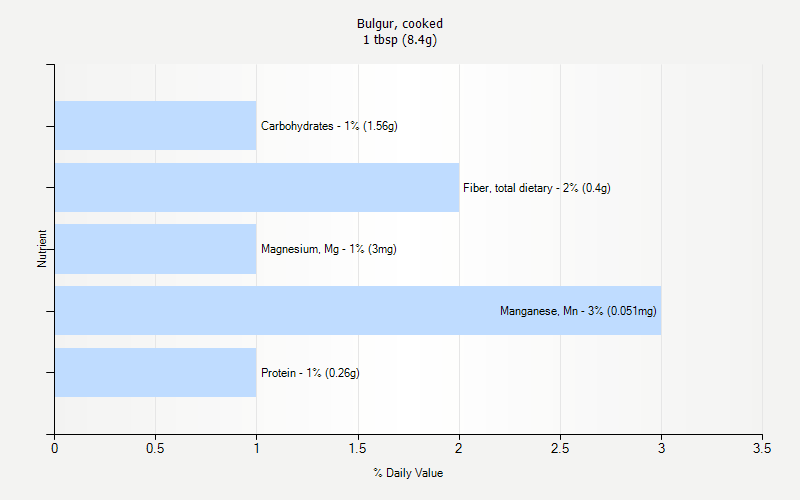
Das solltest du über Bulgur wissen eatsmarter.de ernährung
What are the benefits of bulgur wheat? In addition to vitamins and minerals, whole grains supply important plant-based antioxidants and phytonutrients, including phenols, hydrophilic compounds and lipophilic compounds that lower inflammation and prevent free radical damage.

Bulgur cracked wheat GLYCEMIC INDEX based on 5 tests from Canada among
The glycemic index (GI) is a value used to measure how much specific foods increase blood sugar levels. Foods are classified as low, medium, or high glycemic foods and ranked on a scale of 0-100.

Bulgur is one of several lesserknown whole grains that pack a wealth
The GI is a scale out of 100 that ranks a carbohydrate-containing food or drink by how much it raises your blood sugar levels after it is eaten or drank. Foods with a high GI increase blood sugar higher and faster than foods with a low GI. There are three GI categories: low GI (55 or less) medium GI (56-69) high GI (70 or more)

low glycemic food list printable Google Search Glycemic load, Low
Manganese: 1.11mg Phosphorus: 72.8mg Carbs One cup of cooked bulgur provides 33.8 grams of carbohydrate. The glycemic index of cooked bulgur is 46, which is considered low. Although bulgur is not a low carbohydrate food, it is high in fiber, which makes it filling and nutrient dense. Fats
Family Nutritionist Bulgur better than rice
Check out our full article on Bulgur glycemic index Check out our Glycemic index chart page for the full list. 47 Mineral coverage chart Calcium Iron Magnesium Phosphorus Potassium Sodium Zinc Copper Manganese Selenium Choline 3% 36% 23% 18% 6% 1% 16% 25% 80% 4% 4% Calcium: 10 mg of 1,000 mg 1% Iron: 0.96 mg of 8 mg 12%

Effortless & Wholesome Grains, Part 2 Bulgur
We Recommend Health Millet for Diabetes: What to Know About the Ancient Grain Nutrition 3 Benefits of Whole-Grain Pasta (and Why It's Better Than White) Nutrition If You Have Diabetes, Is It Bad to Eat Corn? Due to its high fiber content, bulgur takes longer to digest, which is why blood sugar levels remain stable.

Bulgur, cooked nutrition
Glycemic index of bulgur The glycemic index (GI) of bulgur equals to 55, which classifies it as a low GI food. Glycemic load of bulgur The glycemic load (GL) of bulgur is equal to 10.2, which classifies it as a medium GL food. Bulgur: Calories and Nutritional info

Bulgur 101 Everything You Need To Know About Cooking with Bulgur in
The Benefits of Bulgur. By Tara Parker-Pope. February 12, 2010 2:22 pm. Andrew Scrivani for The New York Times Bulgur and squash kefteh can be made a day ahead and kept in the refrigerator. In this week's Recipes for Health, Martha Rose Shulman explores new ways to cook bulgur, an ancient grain from the Middle East that's especially.

Bulgur recept Mia’s World
Adding it to your diet may help to improve blood sugar control, heart health, and digestion. Bulgur wheat (also spelled "bulghur") is an incredibly versatile whole grain with ancient roots in.

Bulgur Add fiber to family favorites National Festival of Breads
Low glycemic index (GI of 55 or less): Most fruits and vegetables, beans, minimally processed grains, pasta, low-fat dairy foods, and nuts. Moderate glycemic index (GI 56 to 69): White and sweet potatoes, corn, white rice, couscous, breakfast cereals such as Cream of Wheat and Mini Wheats. High glycemic index (GI of 70 or higher): White bread.

Benefits & Nutritional Value Of Bulgur Healthy Foods Mag
Home Nutrition 5 Benefits of Bulgur, a Whole Grain Nutritionists Love Lauren David Updated: May 20, 2021 Bulgur is a packed with protein, fiber, and vitamins and minerals. Here are the benefits of bulgur, how to cook it, and recipes for making this whole grain. What is bulgur?

Gi Benefits Contact Number Spartan Tree
Most whole grains have a moderate glycemic load (GL), which measures a food's impact on rising blood sugar, with low being the least likely to lead to sudden spikes, according to Harvard Health.

🌱 Healthtips Did you know bulgur promotes bone health? And it also
788 8.1K This is a list of the most popular low glycemic grains. Here you will find a brief description of each whole grain, GI & GL values, general nutrition information, links to low GI grains on Amazon, and a few recipe ideas. You might be surprised to find out that there are quite a few low glycemic grains to choose from.

Bulgur 4 Zubereitungstipps + 3 Wirkungen des gesunden Weizens
Bulgur can be a safe and nutritious option for individuals with diabetes when consumed in moderation and as part of a balanced diet. It offers several advantages for managing blood sugar levels due to its relatively low glycemic index (GI) and high fiber content, which can help stabilize glucose levels and improve insulin sensitivity.

Alternative health tips, healthy lifestyle choices Substitute Rice And
What are the differences between Pasta and Bulgur? Pasta is higher in Vitamin B1, Folate, Vitamin B2, and Vitamin B12, yet Bulgur is higher in Manganese. Bulgur's daily need coverage for Manganese is 17% more. We used Pasta, fresh-refrigerated, plain, cooked and Bulgur, cooked types in this article. Infographic Infographic link Mineral Comparison

A list of healthy low glycemic whole grains such as barley, black rice
If you're wondering if bulgur is a healthy option, the answer is a resounding yes. "You get 6 grams of protein, 8 grams of fiber, and a variety of minerals, including iron and manganese, in just 1 cup of cooked bulgur," Gorin says. So yes, this food is full of nutritional value. More specifically 1 cup of cooked bulgur provides 1: 151 calories.